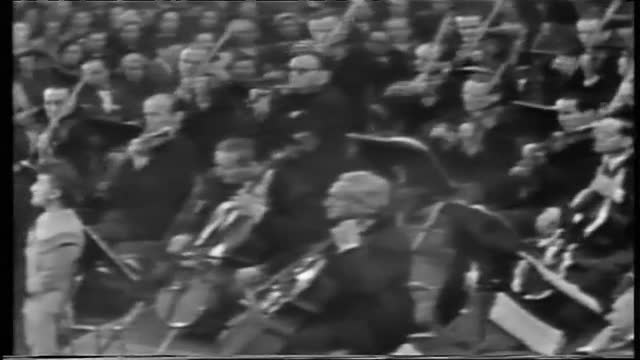Born Rubin Ticker, of Bessarabian Jewish parents who had emigrated to America in 1911, Tucker’s vocal prowess was noted during childhood by his father, who took him to the cantor Samuel Weisser for vocal tuition. After puberty he became a cantorial student, singing with choirs, at weddings and bar mitzvahs; and in 1936 married Sara Perelmuth, whose brother was the successful tenor Jan Peerce (qv).
His father-in-law Louis Perelmuth introduced Tucker to the cantor Joseph Mirsky, who taught him many of the intricacies of cantorial style. After serving as a part-time cantor at Temple Emanuel, Passaic he graduated to full-time positions, firstly at Temple Adath Israel in the Bronx and then at the Brooklyn Jewish Centre. These posts supplemented his main income as the owner, and only salesman, for the Reliable Silk Company.
Tucker studied voice with the tenor Paul Althouse and was later coached in operatic roles by Joseph Garnett. Against Althouse’s advice he unsuccessfully entered the 1941 Metropolitan Opera ‘Auditions of the Air’. He also sang Alfredo / La traviata with the Salmaggi Opera New York, in 1943. The following year, tipped off by the conductor Wilfrid Pelletier, the manager of the Metropolitan Opera Edward Johnson went to hear Tucker sing at the Brooklyn Jewish Centre and offered him a contract with the Met. He made his debut there successfully as Enzo / La Gioconda at the beginning of 1945: henceforth the Met was to be the centre of his operatic career, although he remained active as an occasional cantor.
In Europe Tucker’s debut came in Italy during 1947, at the Verona Arena opposite Maria Callas. His sales skills came to the fore when he was auditioned by Toscanini to sing Radamès / Aida. When it became apparent that Tucker did not know this part, Toscanini indignantly asked why he should bother; to which Tucker’s adroit reply: ‘Because you, Maestro, will teach me Aida, and then it will be 100% correct!’ immediately gained the maestro’s approval. The ensuing radio and television broadcast and commercial recording helped to establish Tucker’s national reputation (although he was not to sing Radamès at the Met until 1965).
The direction of his Met career was quickly established: early roles included Alfredo, Pinkerton / Madama Butterfly, Rodolfo / La Bohème, Riccardo / Un ballo in maschera, the Duke / Rigoletto, Turiddù / Cavalleria rusticana, Edgardo / Lucia di Lammermoor, Gabriele / Simon Boccanegra, Tamino / Die Zauberflöte and (one of his favourite parts) Des Grieux / Manon Lescaut. When Rudolf Bing succeeded Johnson as Manager of the Met in 1950, Tucker was one of the first principals to be re-engaged.
Notable productions in which he sang included the English language Così fan tutte (Ferrando), Don Carlo (title role), Die Fledermaus (Alfredo), Faust (title role), Carmen (Don José) and La forza del destino (Don Alvaro). In 1954 he first sang one of his greatest roles, the title part in Andrea Chénier, where his unique blend of dramatic passion and vocal sumptuousness would drive audiences into a frenzy of excitement. Further parts included Hoffmann / Les Contes des Hoffmann, Cavaradossi / Tosca (both 1955), Lensky / Eugene Onegin (1957), Lionel / Martha, Dick Johnson / La fanciulla del West, Calaf / Turandot (all 1961), Radamès (1965), Manrico / Il trovatore (1966), Rodolfo / Luisa Miller (1968), Canio / Pagliacci (1970) and Samson / Samson et Dalila (1971). His (unplanned) final performance at the Met was as Canio in December 1974. In total he sang in over 600 performances there, establishing an extraordinarily high standard of performance, as many ‘off-air’ recordings bear witness.
With the Chicago Opera Tucker appeared in 1946, with the Chicago Lyric Opera between 1957 and 1964, and with the San Francisco Opera in 1954 and 1955. He sang Cavaradossi at the Royal Opera House, London during the 1957–1958 season, when he also made his debut with the Vienna State Opera as Tamino. From 1960 onwards he sang at the Teatro Colón, Buenos Aires and elsewhere in South America. Although he had recorded La forza del destino with the forces of La Scala, Milan in 1954 for EMI, he did not make his debut at that theatre until 1969, as the Luisa Miller Rodolfo. In the same season, 1968-1969, he sang Manrico in Florence and Des Grieux in Rome, and in 1973 returned to Verona as the Ballo Riccardo. He achieved a long-held desire to sing Eléazar in Halévy’s La Juive: firstly during 1973 in New Orleans and at the Royal Festival Hall, London and then in Barcelona during 1974.
Having already survived one severe heart attack, Tucker died from another while on tour. Uniquely, his funeral took place on the stage of the Metropolitan Opera House. His legacy remains alive in the work of the Richard Tucker Music Foundation, which has supported a galaxy of emerging American singers.
Tucker’s singing was always extraordinarily exciting. His voice was consistently perfectly produced and he gave of himself wholly in terms of dramatic involvement. To quote the critic Jay Harrison in the New York Herald Tribune, reviewing a 1956 Met performance of Manon Lescaut: ‘…so vibrant, so virile, so full of unleashed power’.
© Naxos Rights International Ltd. — David Patmore (A–Z of Singers, Naxos 8.558097-100).
| Title | |
| VERDI, G.: Aida | |

|
VERDI, G.: Aida
Composer:
Verdi, Giuseppe
Artists:
Assandri, Virginio -- Gustavson, Eva -- Harbour, Denis -- NBC Symphony Orchestra -- Nelli, Herva -- Robert Shaw Chorale -- Scott, Norman -- Stich-Randall, Teresa -- Toscanini, Arturo -- Tucker, Richard -- Valdengo, Giuseppe
Label/Producer: Urania Records |
